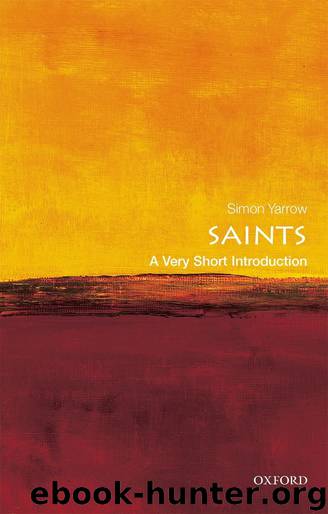Saints by Simon Yarrow

Author:Simon Yarrow
Language: eng
Format: epub
ISBN: 9780191664205
Publisher: OUP Oxford
Published: 2018-07-13T16:00:00+00:00
The Reformation martyrs
The joint enforcement of doctrinal uniformity and loyalty to the state by religious and secular authorities during the Reformation resulted in a new generation of martyr-saints plucked from communities who found themselves on the wrong side of confessional borders. Incidences of martyrdom fed into reform memories and polemic in different ways. Martyrs were particularly important to evangelical Protestants as a vindication of their sectarian claims to revealed religious truth. Luther saw contemporary martyrs as vivid, immediate evidence of God’s living Word that granted true Christians an experience of conditions in the primitive church. He wrote hymns, letters, and responses to the early martyrs of German evangelicalism, Heinrich Vos and Johannes Esch, both executed in Brussels in 1523.
Protestant martyrologists took advantage of the first European age of print media to produce lavish written and visual memorials to their contemporary heroes. Jean Crespin, a French Protestant lawyer and publisher living in Geneva, compiled and published Le Livre des Martyrs in 1554. John Foxe’s Acts and Monuments (1563), more commonly known as Foxe’s Book of Martyrs, did for the history of Protestant England what Bede had done for the Anglo-Saxon Church. In imitation ultimately of Bede’s martyrology, Foxe assembled a new configuration of martyrs from his and earlier ages, portraying in gruesome woodcuts English martyrs such as Ridley, Latimer, and Cranmer on their execution pyres, scrolls unfurling speech from their mouths as if from the pulpit. His book went through four editions within twenty-five years and became a canonical work of English hagiography, and a vaccine against Catholic infection to the English body politic.
English Catholics were obliged to be more discreet in the commemoration of their own recent martyrs. There was no question of them launching canonization procedures with Rome, however worthy of this their priests may have been. The young Jesuits who trained on the continent for service in Elizabethan England, many of whom ended up hanged, drawn, and quartered, seem unlikely descendants of those monk-missionaries Bede portrays in his Ecclesiastical History of the English. But recent scholarship suggests they did act with missionary intent rather than with limited pastoral aims. In their efforts to return the English people to the fold, they swathed their activities in an atmosphere of visions and miracles reminiscent of the early church. Moreover, there was an appetite among the people even in the later decades of Elizabeth’s reign and into the early Stuart era for such providential signs and wonders, and for the relics of those who were martyred.
While the medieval infrastructure of shrines was swept away by iconoclasm and, in England, the monasteries were dissolved, relics were salvaged and distributed privately among clandestine Catholic groups and recusant aristocratic families along with those of newly martyred Catholics. Stonyhurst College in Lancashire, originally a Jesuit foundation for exiled English Catholics of the late 16th century located on the continent (at Saint-Omer), possesses among its collection of martyr relics the 4th-century body of St Gordianus, and the ropes used to quarter St Edmund Campion.
As the new
Download
This site does not store any files on its server. We only index and link to content provided by other sites. Please contact the content providers to delete copyright contents if any and email us, we'll remove relevant links or contents immediately.
Resisting Happiness by Matthew Kelly(2900)
The Social Psychology of Inequality by Unknown(2332)
Designing Your Life by Bill Burnett(2293)
Day by Elie Wiesel(2257)
The Giving Tree by Shel Silverstein(1852)
Angels of God: The Bible, the Church and the Heavenly Hosts by Mike Aquilina(1638)
Human Design by Chetan Parkyn(1587)
Augustine: Conversions to Confessions by Robin Lane Fox(1479)
The Supreme Gift by Paulo Coelho(1457)
Hostage to the Devil by Malachi Martin(1406)
7 Secrets of Divine Mercy by Vinny Flynn(1399)
Jesus of Nazareth by Joseph Ratzinger(1394)
Dark Mysteries of the Vatican by H. Paul Jeffers(1353)
The Vatican Pimpernel by Brian Fleming(1347)
St. Thomas Aquinas by G. K. Chesterton(1324)
Saints & Angels by Doreen Virtue(1315)
My Daily Catholic Bible, NABRE by Thigpen Edited by Dr. Paul(1213)
Called to Life by Jacques Philippe(1209)
The Ratline by Philippe Sands(1175)
